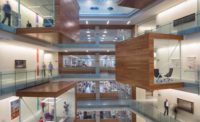
In an economy where acquiring work can sometimes feel like an effort in futility, many specialty contractors find themselves searching for another business stream until new construction recovers. Employees at Seattle-based McKinstry Co. LLC think they have found a way to weather the storm.
The design-build mechanical contractor sums up its services in its motto, "For the Life of Your Building." The company not only designs and builds complex mechanical and electrical systems, it is also available to operate and monitor the finished facility—typically, mechanically intensive data centers and research laboratories. Its push for innovation despite the recession brought it a visit in February 2008 from soon-to-be-elected U.S. presidential candidate Barack Obama.
It's a dramatically different approach than that adopted by most of McKinstry's competitors, who may offer some post-installation maintenance but leave on-site operations to the owner or a separately contracted facilities manager.
McKinstry's non-construction service offerings—of which facilities management is a large portion—have helped to diversify the company, says Doug Moore, president, and contribute to 50% of the firm's approximately $500 million in annual revenue. McKinstry provides 500 million sq ft of facility services to hundreds of clients across the country.
McKinstry was founded in nearby Bellevue, Wash., in 1960 as a 10-person plumbing and piping subcontractor. The firm has grown steadily over the years, adding a design-build component in the 1960s, architectural metals in the 1980s and electrical services in 2003. It now has 19 offices around the country. After weathering the recession of the early 1990s, company leaders started to rethink the structure of the firm. "The company was too susceptible to the economic cycles of large construction projects," says Moore. "We knew we'd have a more stable and safer company through different kinds of revenues."
Good Harmonies
The company reorganized, significantly expanding its maintenance and service offerings. It launched a facilities management group in the mid-1990s, followed by its game-changing Knowledge Response Center, or KRC, in 1999. The KRC complements McKinstry's onsite staff by monitoring buildings in real time. A complex "command center" of sorts, the Seattle-based KRC detects issues within buildings' critical systems, reducing accidents, downtime and costs. It also measures energy usage against performance goals, driving business decisions and cost savings.
For a client like the University of Washington School of Medicine, McKinstry's after-care offerings are critical. McKinstry designed and built the mechanical systems for the school's multiphased research facility. The most recent addition includes five custom air-handling units, three rooftop units, three 400-ton terminal units, six dedicated specialty exhaust systems with redundant fans, 550,000 lb of sheet metal and a diverse plumbing system that includes 35 miles of pipe.
The facility's second phase featured the use of chilled beams—energy-efficient cooling that reduces the amount of air needed. The third phase uses chilled beams as well, plus an innovative heat recovery and exchange system that further cuts energy demand.
McKinstry also holds the facilities management contract and has operated the facility since the first phase in 2005. It is staffed full time by four McKinstry building engineers and monitored remotely by the KRC.
Being involved in the construction as well as the operations of the complex systems offers unique benefits, Moore says. "When designing subsequent phases, we've been there with our builder hat on and as a services and facility manager," he says. "As each phase moves into construction, our facilities management team has been part of the design team, able to influence how the systems can be optimized for energy efficiency."
As the sole point of contact for the mechanical portion, McKinstry can also use building information modeling data from construction in facility management. "Having design and construction integrated with operations creates good harmonies," says Brian Antonsen, project executive for McKinstry's life sciences division and the senior project manager for the UW School of Medicine job. "When we turn the keys over to the UW on Day 1, our staff is ready to fully operate the building and (let them) do science, instead of spending the first six months of occupancy figuring out the systems."
Energy Audits
In addition to facilities management, McKinstry offers energy-auditing services, in which crews assess existing assets and offer building owners and managers infrastructure improvements on their properties. The audits benefit both sides: Clients can make changes to their systems that save big money on energy bills, and McKinstry adds to its non-construction toolkit.
Reaching beyond mechanical and electrical design and construction and offering a robust array of after-care solutions has been a good business decision for McKinstry—and its clients—on many fronts, says Ron Johnson, McKinstry's vice president of facility services.





Post a comment to this article
Report Abusive Comment